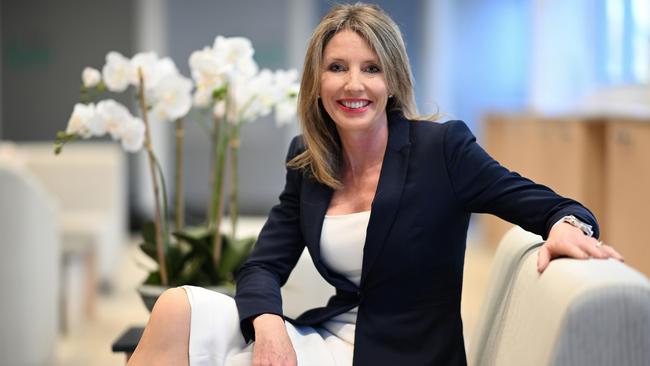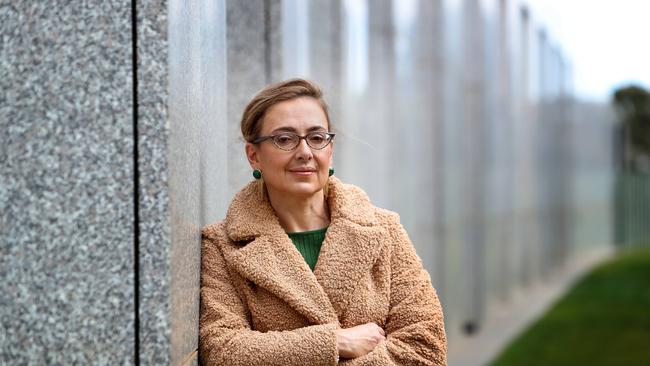Shorter hospital says and robotic surgery: inside Ramsay Health Care’s plan to lift productivity
Productivity in Australia’s healthcare system is lagging below other big industries including agriculture and manufacturing. Here’s Ramsay’s plan to fix it.

Shortening hospital stays, robotic surgery and digitising services are at the centrepiece of Ramsay Health Care’s push to lift productivity.
Staff output has declined to about 5 per cent below 2019 levels at Australia’s biggest private hospital operator after three years of unprecedented interruption from the Covid-19 pandemic, including government-enforced elective surgery bans.
But Carmel Monaghan, chief executive of the group operations – which includes more than 70 hospitals, clinics and surgical centres – says the group has managed to achieve “major productivity gains” as well as work with various governments to cut public waiting lists.
Ms Monaghan said restrictions on elective surgery, a global shortage of skilled health worker and “large increases in input costs” had led to private hospitals shorting the length of stay so “more patients can be treated with less resources.”
“Hospital operators like Ramsay are also heavily investing in robotics and digital technologies that are further increasing our efficiencies – driving down waste and improving patient outcomes,” Ms Monaghan said.
“In the past year alone, Ramsay has invested in 40-plus orthopaedic robots across the business, which are not paid for by health insurance companies, and we have made substantial investments in digitising our business.”
It comes as global consulting firm McKinsey found Australia’s healthcare system had averaged annual productivity growth of 1.9 per cent in the seven years through to 2022, lagging other key industries. This is despite it recording the biggest increase in employment, with an annual growth rate of 4.8 per cent.

Medibank chief executive David Koczkar has warned a failure to lift productivity will make access to healthcare more expensive. He called for the adoption of more “innovative models of care” such as the hospital in the home service that Medibank runs in partnership with not-for-profit healthcare group Calvary on behalf of the South Australian government.
But Mr Koczkar’s call – and similar overtures from Bupa and NIB – have been met largely with resistance from hospital operators, fearing it would lead to US-style managed care, where health insurers have a greater say on a policyholder’s treatment.
While Medibank says it is not seeking to adopt a US-style system, Ms Monaghan warned against a push from health funds into clinical services.
She said private health insurance companies had a role to play in increasing productivity and efficiency in the sector such as reducing administrative burdens such as audit and compliance clauses, and standardising business rules and payment models.
“Ramsay has advocated to have a contestable market for hospital in the home and rehabilitation in the home services which we now provide to thousands of patients, but some health insurance companies refuse to pay for services for their members which they do not own. These services may not be what clinicians recommend, or in the best interest of the patient,” Ms Monaghan said
“We have to be careful that the push by insurance companies for “innovative care models” is not about pushing customers to services they own – which is managed care disguised as consumer choice. I don’t think Australians want a system where patients are being directed into a particular care pathway because it is in the financial interests of the insurance company rather than the best clinical interests of the patient.”

Ms Monaghan said vertical integration by health insurance companies needed to have appropriate regulation, saying if left “unchecked” it could “lead to the same situation banks found themselves in when they owned wealth management funds”.
“Good health outcomes must remain a priority,” she said.
“We have excellent health outcomes in this country – among the best in the world. Australia’s five-year cancer survival rates are among top three in the world for most cancer types; our national joint replacement registry is the best in the world. And we deliver these outcomes cost effectively (about 10 per cent of GDP spent on health compared to about 17 per cent in the US)
“In terms of day surgery, 65 per cent of most surgery is day only. It does not matter whether these services are provided in stand alone day hospitals or in acute overnight hospitals they are still delivered on a day basis. We get efficiencies through doctors being able to deliver care to more complex, sicker and more vulnerable patients alongside their less complex patients.”
But Rachel David, chief executive of Private Healthcare Australia, which represents health insurers, said a contestable market also meant embracing providers outside traditional hospital care.
“There are some terrific providers of hospital care that come from within the traditional hospital sector but there are also disrupters as well. What the funds are looking for is evidence-based models of care that are cost effective and that can be provided at scale, regardless of who’s providing them,” Dr David said.
“What we need to do is to train and incentivise clinicians – be they doctors, nurses or allied health professionals – to be confident in offering out of hospital care.”








To join the conversation, please log in. Don't have an account? Register
Join the conversation, you are commenting as Logout